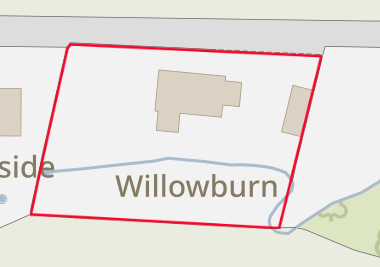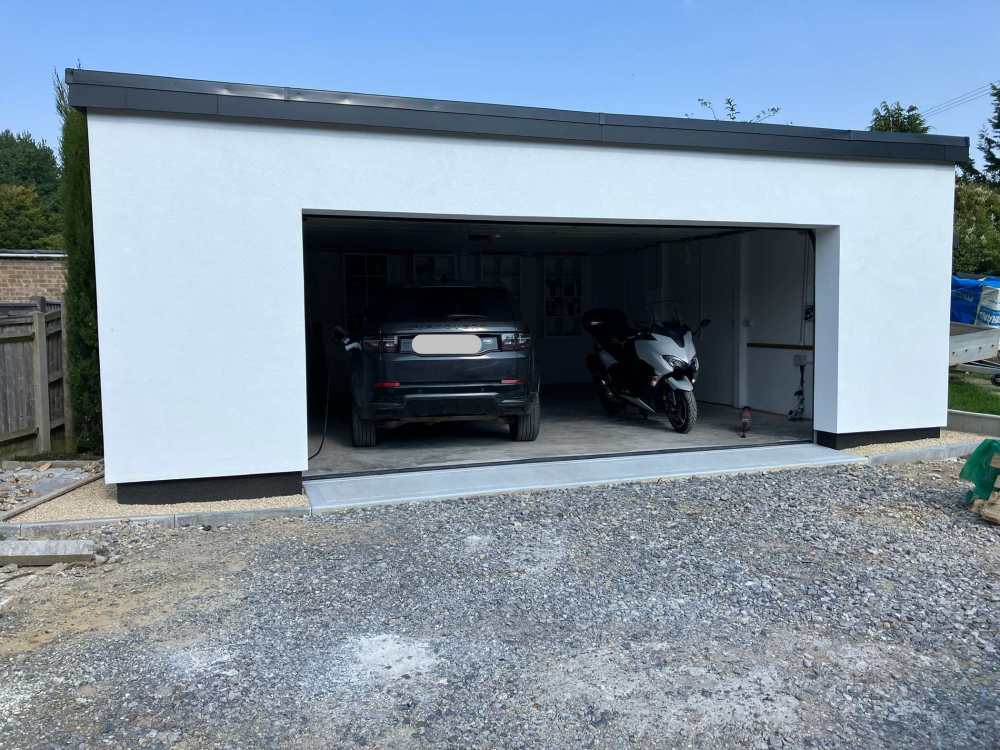Leaderboard
Popular Content
Showing content with the highest reputation on 11/19/24 in all areas
-
Week 9 and 10 The gable ladder is up, and the OSB 3 is installed over the rafters. The overhang supports are shaped for the secure attachments and put up. The South side of the roof gets its cross batten. The scaffolding comes down, unfortunately due to miscommunication between the director of the company in the office and the director working on site the scaffolding comes down before the North side gets battened. The builder has given us the materials and refunded us an amount for the labour. It was always our plan to try and get the foundations and walls put up by the same company, so there is no doubt about site measurements. During the tendering process we found it very hard to get a groundworks team who worked closely with a builder where the combined price was what we expected. We had builders who came and quoted then ‘ghosted us’, perhaps they didn’t like us living so close to the build or like that it was only a shell build. One builder put his estimate in for both groundworks and the build but suggested his mates company could do the groundworks cheaper as he had his own equipment, but his mates quote doubled the first estimate. Which left us with little confidence in the builders estimate. Getting a detailed estimates and quotes for groundworks, build and roof became nigh on impossible, and I was quite prepared to call the whole thing off or just do the bare minimum to secure the building works had started. We had still added value to our land and it would have kept our long term options of selling the land with the planning permission commenced. Eventually we found a building contractor who could do the foundations and the build. Although I ideally wanted a dry shell before we took over the project managing, we are parting company with the builder sooner than planned. This is partly due to his inflexibility of using only his choice of solar installer who wouldn’t put the solar panels on that we wanted. The builders solar installer wanted to install 6.52kwp but I had found panels giving me 8kwp and this was better for us and the SAP/EPC. The builders installer kept looking at an outdated list and saying the panels were not MCS certified. The panels only got their MCS certification in July and despite me telling him the MCS certificate number, checking with the wholesaler and MCS that they were ok he wouldn’t change his mind. Due to the builders rising costs we decided we could no longer continue with his company and instead we have sourced our own roofer and solar installer, who will install the all black 500w panels I wanted. This has saved us over £12,000 but delayed work slightly as one lot of scaffolding had to come down on the Friday/Saturday and the roofer will put his own scaffolding up on Tuesday. Total man days of labour for week 9 is 14 days. Total man days of labour for week 10 is 17 days. Grand total of labour from building contractor is 157 hours, this has been recorded by me just for reference it does not include any scaffolding, up or down. The actual cost was on a fixed price quote. Total cost to date. Brought forward £45645 Payments to builder for installing ICF walls, internal load bearing walls, stud walls and roof structure £95000 (ICF £15,000 apx) Total to date £140,645 I have quotes for £20k for the roofer, £8k for the solar and £22K for the installed windows. If this all goes to plan thats less than £200k before internals start.2 points
-
More or less done these two rooms now, which after finishing the bathroom were basically just flooring and decorating, making a bit of furniture and then moving some other furniture I already had which was always destined for the dining room. I’ve got planned some bench seating for the wall side of the dining table to make it more space efficient, but not any time soon. I think this will be the first time, certainly in the last 10 years, where I have no outstanding ‘filler that just needs sanding down and painting’ kind of jobs, everywhere has skirting board which is painted… the little things in life. Everytime I walk in the bungalow and see the French dresser, it just melts my heart, knowing that my late wife would have loved to see it where it is now, we did buy it while she was still alive as they were stopping making it and was perfect for the look we were going for, managed to bag the dining table off eBay from the same range for around £200 I think brand new, and the chairs were ones we had from ikea which I upholstered and painted white to match. I know the plug sockets need covering, managed to locate them just slightly too high! The bookcase is to be backlit with an LED strip light (awaiting Black Friday being the right bugger I am!) and then will be filled with all my books, photo to follow at some point. The hallway has also been redecorated and the floor sanded and reoiled - out of anywhere this small passageway has suffered the most during the works bringing everything in and out, so was nice to get it back to 100% again2 points
-
If your in the west mids, go and see mark at archital or something like that, I’ve had a couple of grands worth from him, spot on service.2 points
-
Nope, don’t go there unless you are the type that just likes to do stuff just to prove it can be done. there are many proven ways to build a house, looking for something new is just silly, you will struggle to get trades to do it, you will struggle to get a mortgage, and also to insure it, as well as structural engineer to design other bits around it. im aware of the product as it’s used extensively to build commercial buildings, and I did a bit of that previously.2 points
-
2 points
-
If you're concerned about the planet and you think your gas utility are going to put hydrogen in your gas pipes, you should definitely install a heat pump. Let's hope someone can explain the second law of thermodynamics to our politicians so that this never happens. Burning green hydrogen for home heating would be madness. It will be expensive and bad for the planet. Getting a kWh of heat into your house by burning hydrogen will require six times more renewable energy generation than doing it with a heat pump. That's six times as many wind turbines and PV panels. The priority for green hydrogen should be to use it in applications where there is no alternative, e.g. fertiliser (ammonia, urea), chemicals manufacture (methanol) and oil refining which currently get their hydrogen from natural gas. If all of the existing renewable electricity in the world were used for those industrial uses, it would not be sufficient for the current industrial demand. Before we even think about burning hydrogen, we should use it first for those applications. If you're interested in reading more, check out Michael Liebreich's Hydrogen Ladder.2 points
-
I don’t think a property being on the findmyaddrees search has any link to land registry and titles. When I use findmyaddress I can find my existing property and the unfinished new build. Our land is all under one title with two properties on it and both addresses are correct on the search. I presume in my case it’s because Cornwall council have assigned us a UPRN either when we named the build or now we have started the build. From the website. UPRNs are allocated against a property or street as soon as ‘construction' begins or ‘street naming and numbering' has been carried out – whichever comes first. try searching on here https://www.gov.uk/search-property-information-land-registry on this search my existing property it gives some details and says for example the name how HM Land Registry have described the property in the register. But for my new build not registered it says ‘no information held’ which is correct, until we split the title Land Registry don’t know about it.1 point
-
1 point
-
I agree but worth a call to them. Shall update here what they say.1 point
-
1 point
-
If you ever have a burst under there, you'll need to lay a new pipe around the house. I'd replace it with 25mm MDPE and place in a 100mm duct under the footing.1 point
-
1 point
-
Shutting the industry down is a nonsense. There are plenty of perfectly valid applications for spray foam. No doubt there are cowboys, so do something about them instead. Stop giving government grants to them would be a good starting point.1 point
-
The land registry maps are OS derived. I think the OS do a good job of mapping new buildings that appear on land. I never told them anything but like you the LR OS map now shows a pretty good outline of the buildings on the site, including our static caravan. I did once see a man with a packpack with an aerial on it, walking around the perimeter of a new build house clearly recording the position of each corner of the building. Someone must have done that here, but nobody asked my permission to do so.1 point
-
Your build requirements were much the same as mine, and I would say that is pretty normal for self builders. But most self builders are quite different to mass market house buyers. I self built (twice) because mass market builders at the price I could afford only offer row after row of identikit boxes crammed in tight together with small gardens and little regard to views or which way faces south.1 point
-
If you’re married it won’t matter but it’s always better to have stuff you jointly own in joint names. My other half has had no end of grief trying to sort her dad’s stuff out after he died because it was in his name only. Further complicated because she has PoA for her mum.1 point
-
I am using a 5kWh Sunsynk inverter. I have two Sunsynk batteries with comms to the inverter so charge / discharge is all good. The additional AOLithium batteries I am adding are being added in 'dumb' mode so are only connected electrically in parallel via the +ve & -ve 48v terminals. There is no active comms between them or to the existing Sunsynk batteries. As they are all same 16S architecture they charge and discharge in harmony. £649 ind free delivery and the cables (normally around £50 - £80) is an absolute bargain and too good to resist 🙂 the plan is to charge overnight and run the rest of the day on batteries. Payback circa 2 - 3 years. I have just been looking at the Tomato Lifestyle tariff, this gives 00:00 to 06:00 at 5p /kWh and a couple of other cheap periods a little like Cosy.1 point
-
The Alumasc stuff looks nice but it is very expensive. I have two 3500mm x 400mm parapet walls to cap and I'm looking at over a grand in Alumasc which seems very punchy. I'm in Kent too and looking for a recommendation for a local fabricator. I had fascia made, but the end caps probably need to be fabricated to get a good finish Regards Tet1 point
-
Whoever owns the land owns the buildings on it, unless they are leased to someone by leasehold1 point
-
Land registry etc would have been dealt with when you bought it, whatever it was then, even an empty piece of ground (as ours was). Not something you usually have to worry about at completion. Do you find it listed here? https://www.findmyaddress.co.uk/search1 point
-
No silly idea, the cost of the plywood would be dearer than getting a plasterer for a day. get all the paper off and make it easy for him. Get a reasonable finish then hang lining paper and paint.1 point
-
What I did was each invoice even if multiple pages was 1 pdf so multiple pages on one file. And when I got to 20, I then went through there complicated add extra documents, then added the extra invoices and in the description said this was a document they asked for. I uploaded 28 this way.1 point
-
No it's not. Says company selling it. No, it's for a different scale of building, and had plenty of cons.1 point
-
We're at an early stage of sourcing similar. I was also going to mention Guttercrest. Alumasc Skyline look like a more 'off the shelf' option1 point
-
Look up, GUTTERCREST, they fabricate this sort of stuff. if you go for aluminium it will look the best, but cost the most. zinc coated steel is available, but will have a bit of a wave effect as it’s relatively thin. there’s a company in the midlands who also fabricate these in aluminium, I’ve had all my window cills from them, very nice stuff, but I cannot remember the name, something like ARCHITAL.1 point
-
The corner pieces overlap the straight fascia bits. One of the reasons I had them locally fabricated is that the corner in the picture below is not a standard 90 degree corner but 75 degrees. I designed mine to be fixed through the soffit element (which would be hidden by the EWI) and the top of the fascia element (that would be hidden by the PVC). The hidden fixing bit worked, I’m just disappointed in the finished look - however you don’t really see it unless it’s pointed out so I should get over it eventually!1 point
-
I got a local metal fabricator to make some for me for my garage roof. I screwed up though as we have an EPDM roof which is finished off with a PVC trim piece. I should have had the metal fascia the full height of the roof fascia with the PVC trim over the top of the metal but I stopped the metal short, pretty much level with the base of the PVC trim and it looks a bit rough. I’ll draw a picture to clarify the above if you’d like.1 point
-
Sorry I should have said to put a layer of 20 x 70 strapping under the PIR on slope to create a service cavity too.1 point
-
Yup, if you were using self tapping screws into metal you would drill a hole first, unless you were using Tek screws when you wouldn't have to drill a hole.1 point
-
This is the reason the structural engineer chose RHS For such a long beam on the inner skin we would not recommend using a UB section, as they are prone to twisting and torsion, and would likely need a really large section size to overcome that, which probably wouldnt look great. RHS beams are not prone to torsion due to their shape. Should I still pursue a UB?1 point
-
Over a years delay due to his oversight and refusal to listen to the planning officer. When planning said no the first time, (due to his dormer flat roof design being higher than the ridge) he came back with a ludicrous design that was close to a Dutch barn roof that was also refused, he then drew designs for a standard pitched roof on top of the loft conversion so the end had two gables.. I refused to let him submit those to planning and gave him my interpretation of external after a conversation with planning officer. Which was finally accepted. It was then we discovered just how impractical his original drawings were, and the ones thereafter. There were many issues. The whole project was nearly abandoned. Finally found a good SE and a Posi-joists company who managed to make it work. But by then the post-covid building material costs had doubled.1 point
-
Sheeps wool is ace for clothing. I love my 100% wool jumpers. I wear them every day until they are full of holes. However I'm not a big fan of it for insulation. It's very dear and can attract wee beasties more than some other alternatives. I would not use it if you are budget constrained. Cellulose is a great option, as in mineral wool. I'm usually not mega keen on PIR boards but I think @nod is spot on here. My suggestion for the roof is this. On the slant, Slates Bituminous Felt 75mm ventilated gap 2x50mm layers of PIR with joints staggered and foamed. Inner face of PIR taped and returned to adjacent surfaces. Plasterboard Skim. Horizontal section. Ventilated attic 400mm of Mineral wool or celluloseabive and between joists. (better!)Membrane returned to all adjacent surfaces. 20mm battened service cavity. Plasterboard and skim.1 point
-
Let me modify the above sentence for use in a super insulated modern house. "But first, writh uncomfortably by the fire, sweat dripping off the hairs on your toes, stareing into the lava hot, death furnace, as the steaming cocoa liquidifies your skin and the neighbours are asphyxiated by the emerging smell of melting human flesh".1 point
-
I wonder if part of the issue is the lack of a feedback loop. I have the impression that on lots of projects, the architect does the getting through planning and maybe building regs submission, then they focus on the next project. Where, in general, do they get their homework marked in the light of building what they’ve designed? And if they aren’t getting that feedback how can they be expected to either improve or even keep up with rapid product and technology developments?1 point
-
I looked at the first picture you posted and held my head in my hands. In a different world you might be able to just lock the site gate and come back in 6 months,or a year, or two years when conditions were favourable. Alas impractical with all the paperwork following building . Another option would be to park the shovels and design some easier to build foundations like piles with a ringbeam or such. However we are where we are etc..... Before trying to pin your builder to the wall with emails maybe try to climb into his boots for a second. Take him to a nice cafe somewhere, on the clock, buy some buns, and have a grown up discussion. Importantly, listen to him. I know it's frustrating to see the budget and schedule slipping but I think it's the ground eating it. Not your builder. Resist for now the temptation to bolster the moral of men, up to their knees in sh*t, with dictatorial emails.1 point
-
Hmmmm. Understood and I agree with all but one point: regardless of the actions of others we will continue to consider others, even when their feelings are irrational or in our eyes unreasonable we’ll still do our bestest to be nice. That said balance is needed, and we politely tried to ease their concerns and went ahead planned in the ASHP anyway as we believed it to be the right thing to do. I guess I reacted to the unexpected and unwelcome extra cost in an emotional manner. I try not to do that too often. The plan is to go for v airtight with MVHR and sensible insulation levels for a modest house. Jeremy’s spreadsheet tells me at the lowest temperatures outside that we can reasonably plan on will require just over 2kW to maintain 21C inside. Whilst our design does not have significant amounts of glazing we really value the idea of ASHP cooling and we’re building in a fancoil in our bedroom to boost the effect of cooling the slab downstairs. Probably the weakest part of the plan is my penchant for washing up in very hot water. So rather than destroy the COP for DHW we’re having a Quooker tap thingy to top the bowl ready filled from the tank. The original motivation to go all electric wasn’t financial. I happen to believe that tariffs and subsidies should be set up to reward doing the right thing but life’s not always like that. The thing that really got my goat was the fact that new gas connections were subsidised. That really pissed me off.1 point
-
1 point
-
You do, but why would you? they will charge an arm and leg and give you a rubbish system. DIY it1 point
-
Aaah! It is admirable to go for the sheep's wool and the lime. However, if you were to use modern materials you wouldn't have all that weight and nobody would be questioning the structure. If you have to rebuild or severely reinforce the roof then that counteracts the sustainability intent of the design. Sorry to put a downer on the green ideas, but I think my suggestion could be argued ( shown in numbers even) as more sustainable, if that helps. Pragmatic sustainability. Try multiple methods, test the design, decide if it is appropriate.1 point
-
Ah, That's why your archo has misgivings. The flexi WF is about 20kg/m3 heavier than PIR. However, get a SE to appraise the plans. I have similar plans and my SE has just OK'd my roof for the additional load. Structure is not wildly dissimilar to yours but significantly steeper pitch and bigger purlins. (but mine will have a bit more flexi WF and circa 5mm lime plaster, not 50mm Diathonite) But hang on, that lay-up looks unusual. From the pic I had taken the rafters to be 75mm. However the spec says 100 between rafters, so I guess they must be 100! However no ventilation gap, and I cannot quite understand the breather membrane as an 'interstitial' layer.1 point
-
That roof looks fine and straight. As a side note though, it's probably only in such good condition because of the lack of insulation which kept the timbers warmer and less lightly to suffer from condensation. If you do insulate, you will elevate the risk of condensation significantly. To counteract that you'll need to install an appropriate vapour control membrane. What's your aim for the house? Do you want to flip it or live in it?1 point
-
The Architect would be wrong not to advise of the possibility of the roof work. Can you give us more info? what sort of insulation are you considering. If it and any plasterboard etc are not too heavy then there is a decent chance of the roof you show us being fairly readily reinforced from within. Don't despair but work at a resolution.1 point
-
Then your next call is to a SE Architects can only give an opinion Like the rest of us Get something down on paper1 point
-
Normal practice would be to install a 100 mil insulated plasterboard on the slope and 400 mil above the ceiling Decent insulation which will satisfy BC and won’t break the bank1 point
-
To provide a bit of context to become an Architect takes about 7 - 8 years, a degree coupled with professional development and on the job training. As an SE / Designer I agree with your Architect. Your Architect is giving you good advice. If BC pick this up they may ask. But at the end of the day do you want a safe house or not? BC are not there to make sure your house is structrally safe or be SE's. There may be some way to strengthen the roof in a cost effective way to make it compliant.. don't despair.1 point
-
I showed this conversation to a family member. Architect capital A and contractor. Agreed completely with @Alan Ambrose. An @Icevergetype 3 fairly obviously. You are right. Finding the right one for yourself isn't easy, and the wrong ones are easier to find, being better self publicists.1 point
-
Probably too late now, but at some point this year Johnson & Starley were due to produce a new version of the Aquair 'Heat Interface Unit' to allow a heat pump to supply warm air via the ducts used by those central storage heaters.1 point
-
1 point
-
@nod Please share it in the forum rather than DM. I imagine there's nothing confidential about the size of your plant room!1 point
-
Probably the only 'safe' (in the sense that installers are unlikely to object) tank is one where the coil is at least 3 sq m and the size is at least 45l* (greater of number of bedrooms +1 or actual occupancy). Unfortunately you may also get installers who insist on 28mm primaries to the tank, or using a pre-plumbed tank, so even this is not absolutely guaranteed (incidentally I would run a mile from any installer that wanted to use a pre plumbed tank unless it makes sense in terms of the layout of your house. if they are shoehorning a pre plumbed tank in where it doesn't fit its because they use rookie plumbers and there is less chance of cock-up with a pre-plumbed cylinder ). If you want to get a feel for it you could play with the simulation in the DHW tab in the attached workbook With all the usual warnings that its a theoretical simulation only etc... WC Simulation.xls One of the more rational reasons for large coil size is the risk of cycling towards the end of the heating period if the coil is too small. This is of course a particular problem if you have a high capacity, oversized, heat pump that doesn't modulate down well (as fitted by a fair few installers). Cycling will extend the reheat time quite dramatically. You say you are looking at around 6kW however - at that level you are very unlikely to have a problem with a 'Vaillant' coil size in practice, but of course that wont necessarily convince an installer.1 point












